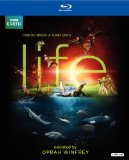“Three years of filming. Seven continents. 70 camera crews. 3,000 shooting days. 200 different species. Groundbreaking technology. It all adds up to the most ambitious natural history series ever created.”
The BBC has been at the forefront of natural history documentaries since the 1950’s. Each decade the teams from the British unit have traversed the globe with what has always been, for the time, the latest in technology. The images that have been captured have entertained and educated the world for more than half a century. In today’s high- definition world, the BBC has not failed to impress with its acclaimed Planet Earth series, among other notable projects. The latest of these is the three-year project, Life.
Life was first broadcast in England, naturally. It featured Sir David Attenborough. For some unexplained reason, this American release of the series does not feature the original narration. The BBC decided that Americans just weren’t sophisticated enough for his amazing authoritive and precise enunciations. Instead, they decided we’d rather have Oprah Winfrey. I’ve only heard segments of the original narrations, but I believe that a great disservice has been done to the American audiences here. I don’t have a problem with the Oprah narration itself. She does a fine job. It just doesn’t carry the majesty and awe that the original displayed. They could have at least given us a choice.
Most nature documentaries have a focus, or at least a theme. Not so with Life, unless you consider the focus just about anything alive. Of course, that means plants and animals, but plants only get one of the ten episodes. Each episode has a particular focus. Most often it concentrates on a particular class of animals such as primates, reptiles, or birds. The later episodes move toward certain behaviors. Here we have such episodes as Hunters & Hunted. Each episode consists of quite a few short segments that fit neatly into each category. That means there is a ton of variety in each episode, but not as much detail on each subject as you would get from the more traditional approach. There is also a fair amount of overlap in the last few episodes which leads to reused segments and footage. You don’t walk away with a ton of specific knowledge, but you do get a crash course on many of these subjects.
But it’s not the knowledge that you’re really going to buy this release for. It’s the stunning photography in glorious high definition, taken with the most state of the art equipment by some of the best nature photographers in the world. There are too many firsts here to mention. The crew did not go for the standard shots that we’ve already seen a million times. This footage is unique and stark in its beauty and realism. I have to warn you that this is not always stuff for the timid. There are many examples of predator behavior taken to its inevitable and quite natural conclusion. There is wonderful macro video that takes us so deep and clearly into the smallest places, places we’ve only imagined before now. There are some time-lapse sequences that allow us to observe the slowest of creatures in new and unusual ways. This is not your father’s Mutual Of Omaha’s Wild Kingdom.
Some of the best segments include Komodo dragons tracking and killing their large prey, orcas entering a shallow tidal pool to get at baby seals, and some nice time-lapse footage beneath polar ice caps.
Video
Each episode of Life is presented in a 1.78:1 aspect ratio. The 1080p image is brought to you through a VC-1 codec. It’s this brilliant picture quality that will drive you to want to own this collection. Warner was careful not to include more than three episodes for each Blu-ray disc. That means bit rates in the mid 30’s or better throughout this collection. It was an admirable choice, and it pays off with the most stunning natural images you’ve likely ever witnessed. The detail here is absolutely startling at times. The sharpness and clarity are like nothing I’ve ever seen in a documentary before. Black levels are superb. Colors are whatever the natural setting demands. Some creatures display wildly bright and exotic hues which are captured here perfectly. Other creatures are drab and live in dull environments. The detail brings even these dusty places to life. This is as perfect a video transfer as I’ve ever seen.
Audio
The DTS-HD Master Audio 5.1 track is also a very impressive presentation. I suspect that many of the environmental sounds were added in post, but whatever their source, the mix puts you right in the middle of these environments. The narration is always crisp and clean. Subtle sounds such as a scratching motion or a crack in an ice field all surround you with quite an immersive experience.
Special Features
All in High Definition.
There’s a few nice full-color pictures in the book keepcase. The discs do overlap. I find that to be a problem.
Production Diaries: Each episode comes with a 10 minute or so behind the scenes feature that picks one or two of the segments and lets you go into the field with the team.
Making Of Life: (42:28) This is actually an episode that puts together some of the best of that behind the scenes footage and includes an Oprah narration.
Final Thoughts
I guess you could call this a nature show “greatest hits”. There are 130 segments in all, covering a wide range of living creatures and plants. It’s an impressive collection that belongs in everyone’s video library. With all of the wildly entertaining films and television shows that we fill our lives and shelves with, there just has to be room for a little slice of the wonders of nature. If you only plan to have one such collection, you could make worse choices. “Open your eyes. The beauty. The power. The wonder. Life.”





